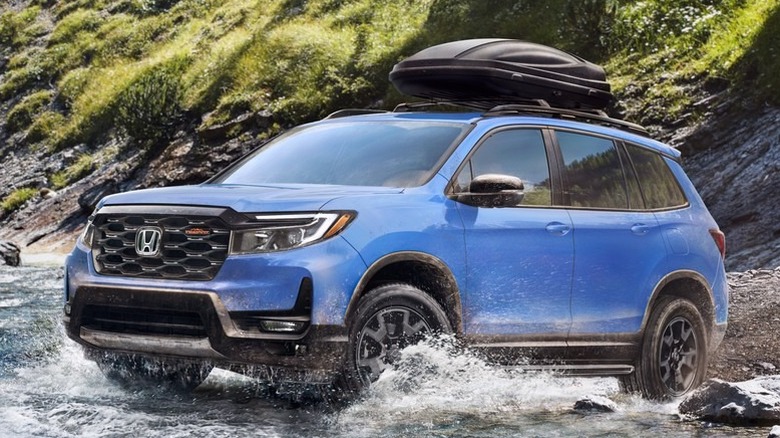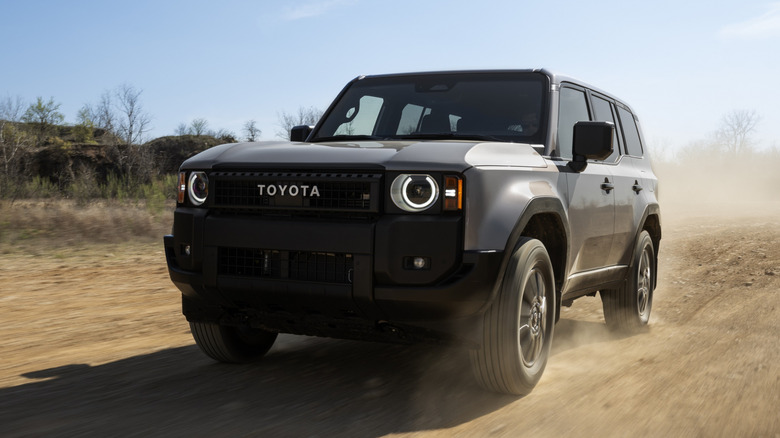6 Alternatives To The Toyota 4Runner
One of Toyota's most rugged and capable vehicles, the 4Runner is an SUV designed with off-roading in mind. It's also one of the most reliable vehicles you can get your hands on. For 2025, the 4Runner is redesigned with all sorts of new features and a completely new look on the outside. It also gets two new powerful engines – the i-Force four-cylinder with 278 horsepower and the i-Force MAX hybrid with 326 hp, respectively. The new engines produce more horsepower than any 4Runner before, and as you'd probably expect, there are several available trims with varying degrees of off-road equipment like all-terrain tires, lift kits, skid plates, transfer cases, and so much more.
The newest 4Runner isn't available yet, though, so your search for a new SUV will have to take you somewhere else for now. We haven't driven the newest 4Runner yet, so we can't say for sure just how it stacks up against other midsize SUVs, but we can recommend a number of impressive alternatives. There's no shortage of SUVs that are comfortable, refined, and respectable enough to cover most terrain when the pavement ends, and these six SUVs are some of the best mid-sizers, offering unique appeal and virtues that could sway potential 4Runner buyers. We've ranked them with the 4Runner in mind, with the strongest competitors for the 4Runner getting the top spots, considering virtues like power, fuel economy, and overall performance. We'll go more in depth regarding our methodology below.
The spacious and upscale Kia Telluride
The Kia Telluride is a top choice amongst midsize SUVs. It's not nearly as rugged as the 4Runner, but that's okay because it has a trick up its sleeve – a spacious third row of seating. The third row is available on certain trims, but it's relatively small and probably not ideal for daily use. Still, families looking for more space should definitely give the Telluride a closer look.
The 3.8-liter V6 under the hood makes 291 hp and 262 lb-ft of torque — enough to give the Telluride plenty of passing power and enough to fall right in between the two available 4Runner powertrains when it comes to output. And for the most part, it matches the 4Runner for fuel economy, too. Depending on the trim level, the new 4Runner gets EPA estimates between 21 and 23 mpg combined, and the Telluride is right there with it, checking in at either 20 or 22 mpg combined, depending on whether you go with front- or all-wheel drive. It's not nearly as off-road oriented as the 4Runner, but the Telluride is available in the upgraded X-Pro trim for a bit more off-road capability than standard models. The Telluride also offers a maximum towing capacity of 5,500 pounds –- definitely within range of the new 4Runner's 6,000 pounds max and certainly enough for a small boat or lightweight utility trailer.
The aging Honda Passport is still a strong contender
Like the 4Runner, the Honda Passport is also a bit of an in-betweener at the moment. The redesigned 2026 Passport is on the horizon, but it's not quite here yet, so the current 2025 model is all that's offered. Thankfully, it's an excellent choice amongst mid-size SUVs. The Passport is upscale, well-built, and has a spacious interior. When we drove the latest Passport, we found the V6's power delivery to be smooth, even if fuel economy left something to be desired. The Passport's 5,000-pound towing capacity helps keep it competitive in the class, albeit slightly behind the 4Runner and Telluride.
The current 2025 Passport uses a robust 3.5-liter V6 that puts out 280 horsepower and 262 lb-ft of torque. Its fuel economy rating from the EPA of 21 mpg combined is respectable, but with no available hybrid powertrain, the Passport is slightly limited compared to the 4Runner when it comes to both power and fuel economy. The Passport is also limited when it comes to off-road capability, but adventurous owners should find it plenty capable, especially in the available TrailSport trim, which offers off-road tuned suspension and all-terrain tires. We expect the upcoming 2026 model to be significantly more capable off-road with specialized suspension and even more off-road equipment like skid plates, but the current Passport is no slouch, and it's still a solid alternative to the 4Runner.
The Subaru Outback is ready for adventure
If you think body-on-frame construction is the only way for an SUV to be capable off-road, the Subaru Outback may just change your mind. Made with the outdoors in mind, the Outback comes standard with a very well-sorted all-wheel drive system, 8.7 inches of ground clearance and an available Wilderness trim that adds even more capability via 9.5 inches of ground clearance and more aggressive all-terrain tires. The spacious hatchback/wagon design means you'll have plenty of space for all your camping gear, too.
For power, the Outback is available with a choice of two engines: a naturally-aspirated 2.5-liter four-cylinder boxer engine that produces 186 hp and 176 lb-ft of torque and a turbocharged 2.4-liter four-cylinder boxer engine that makes 266 hp and 277 lb-ft of torque. Behind the wheel of the Outback, we found the turbocharged engine to be a highlight, along with an impressive highway ride and a well-equipped interior. Both engines have laudable fuel-economy ratings compared to the 4Runner; the 2.5-liter engine has an impressive combined rating from the EPA of 28 mpg combined, while the turbocharged 2.4-liter engine maxes out at 25 mpg combined (the Wilderness trim levels drop to 23 mpg combined). The Outback is no rock crawler, but it might just be refined enough to steal away some 4Runner loyalists who are looking for something more comfortable.
The undeniable Jeep Wrangler
A long-lasting mainstay in the off-road world, it's impossible to do an off-road SUV comparison list without mentioning the Jeep Wrangler. One of the most capable off-roaders available today, the Wrangler can tackle just about any obstacle you throw at it with features like beadlock-capable wheels, 35-inch all-terrain tires, locking differentials, and ultra-impressive approach-and-departure angles. The Wrangler is available in several different configurations, like two- and four-door models, with several different trim levels available on both. There are a plethora of available soft tops and hard tops to choose from, too.
Four distinct powertrains are available: a 3.6-liter V6, a turbocharged 2.0-liter four-cylinder, a rowdy 6.4-liter V8, or the plug-in hybrid. Power ratings range from 270 hp and 295 lb-ft on the turbo four-cylinder all the way up to 470 hp and 470 lb-ft of torque with the monster V8, and each engine provides a unique character for the Wrangler. Unfortunately, the Wrangler isn't the most refined choice in its class. It's so focused on its off-road capabilities that things like ride quality and steering stability suffer. Fuel economy is also a sore spot for the Wrangler -– the EPA rates the V8 at 14 mpg combined and V6 models at 19 mpg combined. Thankfully, the plug-in hybrid Wrangler 4xe is rated at 49 MPGe. Like the Passport, the Wrangler has a maximum towing capacity of 5,000 pounds.
The Ford Bronco offers nostalgia and capability
Like the Jeep Wrangler, the Ford Bronco offers all sorts of configurations and trim levels to satisfy the most specific needs and wants of off-roaders. It can be had as a two-door or four-door model, with soft tops, hard tops, and canvas tops. Big all-terrain tires, lifted suspension, and skid plates are all part of the equation. You can even take off the doors and enjoy some open-air motoring while you're crushing sand dunes. More than just a strong Wrangler competitor, though, the Bronco is friendly as a daily driver, making it a stronger competitor for the 4Runner.
The Bronco has a modern interior that comes with all the latest tech, including a 12-inch infotainment screen. There are three robust engines available for the Bronco: a turbocharged 2.3-liter four-cylinder making 300 hp, a turbocharged 2.7-liter V6 making 330 hp, and a twin-turbo 3.0-liter V6 that puts out 418 hp in the hardcore Bronco Raptor model. Fuel economy estimates with the Bronco are a bit uninspiring, with Raptor models at 15 mpg combined, while four-cylinder Broncos are rated as high as 19 mpg combined. Towing with the Bronco isn't your best bet amongst midsize SUVs, with standard models maxing out at 3,500 pounds and Raptors maxing out at 4,500 pounds. Even with those drawbacks in mind, the Bronco is a top choice in the adventure department, and it won't beat you up on your daily commute.
Sharing a platform with the Toyota Land Cruiser has its benefits
The Toyota Land Cruiser offers retro styling, a bit of an interior upgrade over the standard midsize SUVs, and all sorts of off-road hardware to get out and about in the wild. The Land Cruiser also rides on the same TNGA-F global platform as the 4Runner. That means the Land Cruiser is super capable off-road, and it matches the 4Runner's 6,000-pound towing capacity. Under the hood, the Land Cruiser exclusively uses the 4Runner's optional big-power hybrid engine, the i-Force MAX, putting out the same 326 hp and 465 lb-ft of torque. Like similarly equipped trims of the 4Runner, the Land Cruiser's EPA fuel economy estimate checks in at 23 mpg combined.
The Land Cruiser is notably more expensive than the 4Runner, though. Base model Land Cruisers start at $56,450 (plus a $1,450 destination fee), while the base 4Runner starts at $40,770 (plus destination). For some buyers, we think it could be worth the extra cost. The Land Cruiser is notably more upscale, with high-quality materials and a premium vibe on both the inside and outside.
Methodology
For this list, we decided to rank our choices based on how well they compete with the newest 4Runner. The 4Runner is a capable, spacious, midsize SUV, so those were some of our basic parameters. Each one of the rivals listed here has some sort of off-road capability, ranging from basic rough-road competence all the way up to conquerors of untamed lands. Decent towing capability, strong engines (either standard or available), and respectable fuel economy ratings all factored into the process as well.







